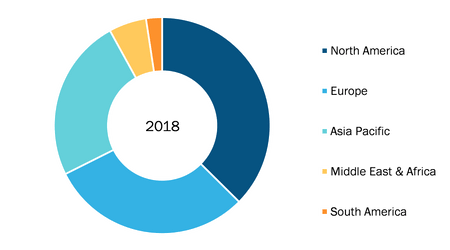The global radar level transmitter market was valued US$ 654.5 Mn in 2018 and is expected to reach US$ 996.0 Mn by 2027 with a CAGR growth rate of 4.8% in the forecast period from 2019 to 2027.
The radar technology is used for the detection of levels in continuous level measurement applications such as chemical, water treatment, food and beverages, and others. Level readings are used for process automation and visualization in the control systems. The technologies used for radar level transmitters are contact and non-contact type of technology where guided wave radar falls under contact type, and pulse and FMCW falls under non-contact type. Factors such as changes in pressure, temperature, density, or measured material can all affect the technology choice. The contact type of technology, such as guided radar pulse measurement is suitable for high temperature as well as pressure. It is also used for various types of complex work conditions in oil and gas and other industries and meets various requirements of different temperatures and pressure. Radar level transmitters are accurate and more reliable for unstable process conditions. It also provides a level measurement solution for various applications.
Level measurement techniques such as radar are instruments that provide the measurement of liquids and other materials through the application of electromagnetic properties of the measuring materials. As a result, devices have a significantly broad scope of use across numerous industrial as well as commercial such as oil & gas, chemicals, food & beverages, paper & pulp, marine, water & wastewater treatment, mining, and pharmaceuticals among other industries. The instruments owing to their functional applications across different industrial processes and production activities have witnessed an unprecedented due to the growing demand for improving production output, especially in the past few years. Furthermore, the increasing demand from different industry verticals has also propelled the market for superior and efficient radar level measurement based instruments among various industry verticals. In addition to this, the recent availability of low-cost radar level transmitters along with the steady decline in average prices of the device over the past decade has facilitated its adoption among small and medium enterprises resulting in their lucrative market growth during the forecast period over ultrasonic technology-based level measurement instruments. Thus, the radar level transmitters are poised to provide numerous profitable lucrative business opportunities for the market players over the forecast period.
Radar level transmitter Market - Geographic Breakdown, 2018
Radar Level Transmitter Market Size and Forecast (2021–2031), Global and Regional Share, Trend, and Growth Opportunity Analysis Report Coverage: By Technology (Guided Wave Radar, Pulse, FMCW), Frequency (C&X Band, K Band, W band), Medium (Solid, Liquid), Industry Vertical (Oil and Gas, Chemicals, Food and Beverage, Others), and Geography
Radar Level Transmitter Market Size and CAGR (2023-2031)
Download Free Sample
The report segments the global radar level transmitter market as follows:
Global Radar level transmitter Market - By Technology
- Guided Wave Radar
- Pulse
- FMCW
Global Radar level transmitter Market - By Frequency
- C&X Band
- K Band
- W Band
Global Radar level transmitter Market - By Medium
- Solid
- Liquid
Global Radar level transmitter Market - By Industry Vertical
- Oil and Gas
- Chemicals
- Food& Beverage
- Others
Global Radar level transmitter Market - By Geography
- North America
- U.S.
- Canada
- Mexico
- Europe
- France
- Germany
- UK
- Italy
- Russia
- Rest of Europe
- Asia Pacific
- China
- India
- Japan
- Australia
- South Korea
- Rest of Asia-Pacific
- Middle East & Africa
- South Africa
- Saudi Arabia
- UAE
- Rest of Middle East & Africa
- South America
- Brazil
- Argentina
- Rest of South America
Contact Us
Phone: +1-646-491-9876
Email Id: sales@theinsightpartners.com